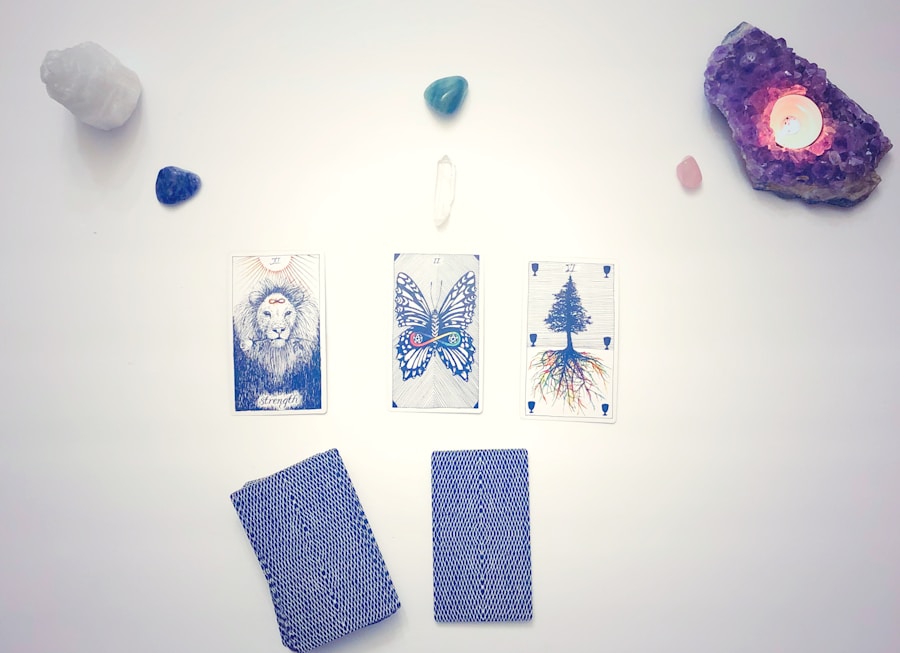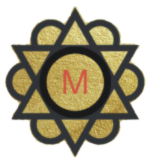
Tarot decks are a fascinating tool for divination, self-reflection, and personal growth. Each deck typically consists of 78 cards, divided into two main sections: the Major Arcana and the Minor Arcana. The Major Arcana comprises 22 cards that represent significant life events, spiritual lessons, and archetypal themes.
Cards such as The Fool, The Lovers, and The World encapsulate profound concepts that resonate with the human experience. In contrast, the Minor Arcana consists of 56 cards divided into four suits—Cups, Pentacles, Swords, and Wands—each representing different aspects of life such as emotions, material concerns, intellect, and creativity. The imagery on tarot cards is rich and symbolic, often drawing from various cultural, historical, and mythological sources.
This symbolism serves as a language through which readers can interpret the cards’ meanings in relation to their questions or situations. While traditional decks like the Rider-Waite-Smith are widely recognized for their iconic imagery, many contemporary decks offer unique artistic interpretations that can resonate with different individuals. Understanding these basics is crucial for anyone looking to delve into the world of tarot, as it lays the foundation for deeper exploration and interpretation.
Key Takeaways
- Tarot decks consist of 78 cards divided into Major and Minor Arcana, each with its own symbolism and meaning.
- The Rider-Waite-Smith, The Wild Unknown, The Modern Witch, The Light Seer’s Tarot, and The Everyday Tarot are great options for beginners.
- Look for decks with clear imagery, a guidebook, and a manageable number of cards to start with.
- Consider your personal connection to the artwork, the deck’s theme, and your intuitive response when choosing a tarot deck.
- Start by familiarizing yourself with the cards, practicing daily draws, and seeking guidance from experienced tarot readers or online resources.
Top 5 Tarot Decks for Beginners
For those just starting their tarot journey, selecting the right deck can significantly enhance the learning experience. The Rider-Waite-Smith Tarot deck is often recommended for beginners due to its straightforward imagery and rich symbolism. Created in 1909 by artist Pamela Colman Smith under the guidance of Arthur Edward Waite, this deck has become a cornerstone in tarot reading.
The illustrations are vivid and accessible, making it easier for novices to grasp the meanings of each card. Another excellent choice for beginners is The Wild Unknown Tarot by Kim Krans. This deck features hand-drawn illustrations that evoke a sense of nature and spirituality.
Its minimalist design allows readers to connect with their intuition without being overwhelmed by complex imagery. The accompanying guidebook provides insightful interpretations that are both relatable and profound, making it an ideal companion for those new to tarot. The Everyday Tarot by Brigit Esselmont is also a fantastic option for beginners.
This deck simplifies traditional tarot concepts while maintaining a modern aesthetic. Each card is designed to be approachable, with keywords and phrases that help users quickly understand their meanings. Additionally, the deck comes with a comprehensive guidebook that offers practical advice on how to conduct readings and interpret the cards effectively.
The Light Seer’s Tarot by Chris-Anne is another popular choice among novice readers. This deck combines vibrant artwork with contemporary themes, making it appealing to a wide audience. The imagery encourages personal reflection and emotional exploration, which can be particularly beneficial for those seeking deeper insights into their lives.
The accompanying guidebook provides detailed explanations of each card’s meaning, along with suggestions for various spreads. Lastly, the Modern Witch Tarot Deck by Lisa Sterle offers a fresh take on traditional tarot imagery. Featuring diverse representations of gender and ethnicity, this deck resonates with a contemporary audience while still honoring the classic structure of tarot.
Its colorful illustrations and relatable themes make it an engaging choice for beginners looking to connect with the cards on a personal level.
Features to Look for in a Beginner-Friendly Tarot Deck

When selecting a tarot deck as a beginner, several features can enhance the learning experience and facilitate intuitive readings.
A deck with straightforward illustrations allows new readers to easily identify symbols and themes without feeling overwhelmed.
Look for decks that provide visual cues that resonate with your personal experiences or emotions; this connection can significantly aid in interpretation. Another essential feature is an accompanying guidebook that offers detailed explanations of each card’s meaning. A well-written guidebook can serve as a valuable resource for beginners, providing insights into traditional interpretations while also encouraging personal reflection.
Some guidebooks include practical exercises or spreads that can help novices practice their skills and build confidence in their readings.
A deck that feels comfortable in your hands can make a significant difference during readings.
Thicker cardstock tends to be more durable and easier to shuffle, while larger cards may be more visually striking but harder to handle for some users. Ultimately, finding a balance between aesthetics and practicality is key. Lastly, look for decks that resonate with your personal style or interests.
Whether you prefer whimsical designs, minimalist aesthetics, or culturally rich imagery, choosing a deck that speaks to you will enhance your connection with the cards. This emotional bond can lead to more meaningful readings and a deeper understanding of the tarot’s potential.
How to Choose the Right Tarot Deck for You
Choosing the right tarot deck is a deeply personal decision that can influence your entire tarot journey. Start by considering your own preferences in terms of art style and themes. Do you gravitate towards traditional imagery or modern interpretations?
Are you drawn to decks that feature specific cultural motifs or those that emphasize nature? Reflecting on these questions can help narrow down your options. Another important factor is your intended use for the tarot deck.
Are you looking to use it primarily for self-reflection and personal growth, or do you plan to read for others? Some decks are better suited for introspective work due to their gentle imagery and themes, while others may be more appropriate for public readings because of their clarity and directness. Understanding your goals will guide you toward a deck that aligns with your intentions.
It can also be beneficial to explore different decks in person if possible. Visiting a metaphysical shop or attending tarot fairs allows you to handle various decks and see how they resonate with you physically and emotionally. Pay attention to how each deck feels in your hands and how you respond to its imagery; this tactile experience can be incredibly revealing.
Finally, consider seeking recommendations from experienced tarot readers or online communities dedicated to tarot practice. Engaging with others who share your interest can provide valuable insights into which decks have been particularly helpful or inspiring for them. Online platforms often feature reviews and discussions about various decks, allowing you to gather information before making your decision.
Tips for Using Tarot Decks as a Beginner
As a beginner in tarot reading, establishing a consistent practice can greatly enhance your understanding of the cards and their meanings. Start by setting aside dedicated time each week to engage with your deck. This could involve daily draws where you pull one card each morning to reflect on its message throughout the day or conducting more extensive readings on weekends when you have more time to delve into interpretations.
When performing readings, it’s essential to create a conducive environment that fosters focus and clarity. Find a quiet space where you feel comfortable and free from distractions. Some readers find it helpful to light candles or burn incense to set the mood, while others prefer simply having a clean surface on which to lay out their cards.
Establishing this ritual can help signal to your mind that it’s time to engage with the tarot. As you begin interpreting the cards, trust your intuition alongside traditional meanings. While guidebooks provide valuable insights, your personal associations with each card can lead to unique interpretations that resonate more deeply with your situation.
Keep a journal where you document your readings, thoughts, and feelings about each card; this practice not only helps reinforce your learning but also allows you to track your progress over time. Additionally, don’t hesitate to experiment with different spreads as you become more comfortable with the cards. While beginners often start with simple three-card spreads (representing past, present, and future), exploring more complex layouts can provide deeper insights into specific questions or situations.
As you gain confidence in your abilities, consider incorporating intuitive spreads that align with your personal style.
Resources for Learning Tarot Reading

Books: A Comprehensive Guide to Learning Tarot
One of the most accessible ways to learn is through books dedicated to tarot practice. Titles such as “The Ultimate Guide to Tarot” by Liz Dean offer comprehensive overviews of card meanings, spreads, and practical exercises designed for beginners. Similarly, “Seventy-Eight Degrees of Wisdom” by Rachel Pollack delves into both the history and philosophy behind tarot while providing insightful interpretations of each card.
Online Resources: A Wealth of Information
Online platforms also offer a wealth of information for aspiring tarot readers. Websites like Biddy Tarot provide free resources including card meanings, sample spreads, and articles on various aspects of tarot practice. Additionally, YouTube hosts numerous channels dedicated to tarot education where experienced readers share tips, tutorials, and live readings that can enhance your understanding of the cards.
Community and Interactive Learning
Social media platforms have also become valuable spaces for learning about tarot. Joining groups on Facebook or following tarot-related accounts on Instagram can connect you with a community of fellow enthusiasts who share insights, experiences, and recommendations for decks or resources. Engaging in discussions within these communities can provide support as you navigate your own tarot journey. Lastly, consider enrolling in online courses or workshops focused on tarot reading. Many experienced practitioners offer structured programs that guide beginners through the intricacies of card interpretation and reading techniques. These courses often include interactive elements such as live Q&A sessions or group readings that foster a sense of community while enhancing your learning experience.
If you are a beginner looking to explore the world of tarot cards in 2025, you may want to consider starting with the Wheel of Fortune card. This card holds deep meaning and symbolism, as explained in detail in the article The Meaning and Symbolism of the Tarot Card Wheel of Fortune. Understanding the numerology behind the number 9 can also provide valuable insights into the tarot deck, as discussed in






